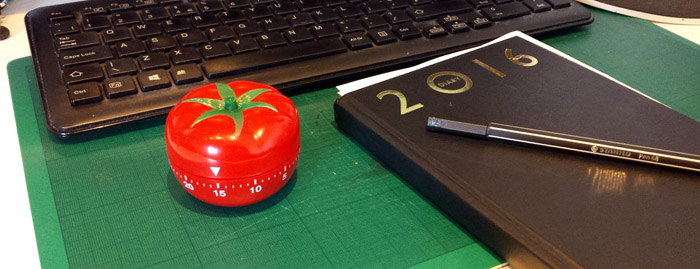

Time-boxing with the Pomodoro technique
I spend a sizeable proportion of my time researching strategies for independent studying. Every now and then I find something that resonates with me on a personal level and I feel I have to test it immediately. Last week I came across a time management tool called the Pomodoro technique and I was struck by its immediacy and simplicity. I am really excited about its application not only for helping students in developing positive revision habits but also for managing my time when working alone.
What is it?
Essentially, the Pomorodo technique is a time-boxing strategy. A Pomodoro (Italian for tomato) is a unit of time, usually 25 minutes. Each Pomodoro is a period of time for which you focus on a single task and nothing else. The idea is that a lot can be achieved in 25 minute portions IF you are fully focused and free from distractions. All social media platforms need to be shut down, phone turned to silent etc… Distractions are the enemy of focus and therefore need to be managed with discipline. At the end of each Pomodoro, a five-minute break is taken before beginning the next Pomodoro.
Probably the best thing about the Pomodoro Technique is how easy it is to start.
Step 1 – Get yourself a timer (it could be a physical kitchen timer or an app on the phone/computer).
How it worked for me
I found that using the timer on my phone did not work so well for me; I would regularly forget to turn it on. I then decided to buy an actual kitchen timer in the shape of a tomato! This worked so much better for two reasons: 1) the tomato sitting on my desk became a visual reminder of my pursuit in using my time more efficiently. 2) The audible ticking of the timer keeps me focused and helps me to stay on task.
Step 2 – Make a list of your major projects and/or objectives and break them down into a set of tasks.
How it worked for me
I use three elements in planning and tracking my time:
- an old-fashioned day-to-a-page A5 diary (for minor to-do tasks)
- a CRM system called Insightly to track and manage large projects (CRM: client relationship management)
- an excel timesheet to record my hours
The official Pomodoro technique describes the use of three sheets: the activity log, the to-do list and the record log. Before I began to apply the Pomodoro technique myself, I realised that I was already using these systems within my three elements and so I just applied the 25-minute working cycle to my existing system, and it’s working really well. In essence, what I saw in the pomodoro was a focusing assistant rather than an entire system and have therefore applied just that one component.
Step 3 – Set the timer for 25 minutes and focus on your most pressing or critical task for the duration of the Pomodoro.
How it worked for me
I am finding the kitchen timer to be an invaluable tool in my pursuit of increased productivity and efficiency. I have been sharing the 20-30 minute concentration model with students for many years and thought that I had been applying it myself. On reflection however, I realise that my focus has been dependent on my enjoyment of the activity and an absence of distractions. The application of the 25 minute Pomodoros now allows me to fully focus on a task which I have been putting off because, guess what? It’s only 25 minutes! How bad can it be? And now I realise – with 25 minutes of full focus – that task will always be completed. I can breathe a sigh of relief and move on to a task I enjoy.
I am believer in using the pieces of a technique that click with me, rather than an all-or-nothing approach and therefore I am already moulding the technique to fit my work flow. Here are some of my personal amendments:
- If I have finished a task before the end of a Pomodoro, then I complete some minor administrative tasks to fill the Pomodoro. I can then log the Pomodoro as a half-hour segment in my timesheet.
- If a Pomodoro comes to an end and I have almost finished a task, then I complete the task before having a break, still logging it as one Pomodoro in the timesheet.
- Between each Pomodoro, I reply to any essential work emails and make a Skype or phone call if needed. I ensure that I stand up and exit the room for a short time and do something different (e.g. make cup of tea / stroke dog / feed fish). I also afford myself a moment to check one tech platform (facebook / eBay / LinkedIn). Then I wind up the Pomodoro and I’m back in the game.
This has been a revelation for me. If you suffer from procrastination / distractionitis, then I wholeheartedly recommend you try it too.
Yours pomodoringly,
Sander de Groot
Click here to read about the technique in more detail


